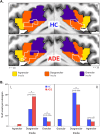This is a preprint.
Hemispheric divergence of interoceptive processing across psychiatric disorders
- PMID: 38105986
- PMCID: PMC10723463
- DOI: 10.1101/2023.12.08.570759
Hemispheric divergence of interoceptive processing across psychiatric disorders
Update in
-
Hemispheric divergence of interoceptive processing across psychiatric disorders.Elife. 2024 Nov 13;13:RP92820. doi: 10.7554/eLife.92820. Elife. 2024. PMID: 39535878 Free PMC article.
Abstract
Interactions between top-down attention and bottom-up visceral inputs are assumed to produce conscious perceptions of interoceptive states, and while each process has been independently associated with aberrant interoceptive symptomatology in psychiatric disorders, the neural substrates of this interface are unknown. We conducted a preregistered functional neuroimaging study of 46 individuals with anxiety, depression, and/or eating disorders (ADE) and 46 propensity-matched healthy comparisons (HC), comparing their neural activity across two interoceptive tasks differentially recruiting top-down or bottom-up processing within the same scan session. During an interoceptive attention task, top-down attention was voluntarily directed towards cardiorespiratory or visual signals, whereas during an interoceptive perturbation task, intravenous infusions of isoproterenol (a peripherally-acting beta-adrenergic receptor agonist) were administered in a double-blinded and placebo-controlled fashion to drive bottom-up cardiorespiratory sensations. Across both tasks, neural activation converged upon the insular cortex, localizing within the granular and ventral dysgranular subregions bilaterally. However, contrasting hemispheric differences emerged, with the ADE group exhibiting (relative to HCs) an asymmetric pattern of overlap in the left insula, with increased or decreased proportions of co-activated voxels within the left or right dysgranular insula, respectively. The ADE group also showed less agranular anterior insula activation during periods of bodily uncertainty (i.e., when anticipating possible isoproterenol-induced changes that never arrived). Finally, post-task changes in insula functional connectivity were associated with anxiety and depression severity. These findings confirm the dysgranular mid-insula as a key cortical interface where attention and prediction meet real-time bodily inputs, especially during heightened awareness of interoceptive states. Further, the dysgranular mid-insula may indeed be a "locus of disruption" for psychiatric disorders.
Conflict of interest statement
Disclosures/competing interest: The authors have no financial or non-financial competing interests to disclose.
Figures







References
-
- Adamic Emily, Avery Jason, Khalsa Sahib S., and Teed Adam Robert. 2021. “Convergence between Goal-Directed and Stimulus-Driven Streams of Cardiorespiratory Interoception.” doi: 10.17605/OSF.IO/6NXA3. - DOI
-
- Adolfi Federico, Couto Blas, Richter Fabian, Decety Jean, Lopez Jessica, Sigman Mariano, Manes Facundo, and Ibáñez Agustín. 2017. “Convergence of Interoception, Emotion, and Social Cognition: A Twofold FMRI Meta-Analysis and Lesion Approach.” Cortex 88:124–42. doi: 10.1016/j.cortex.2016.12.019. - DOI - PubMed
Publication types
Grants and funding
LinkOut - more resources
Full Text Sources
